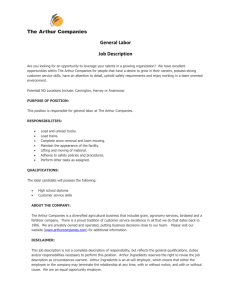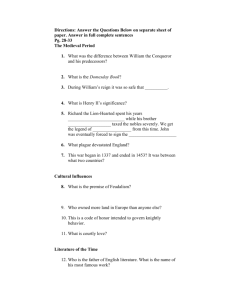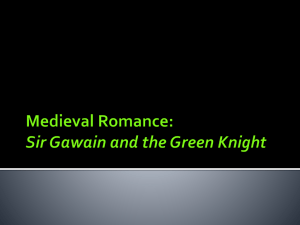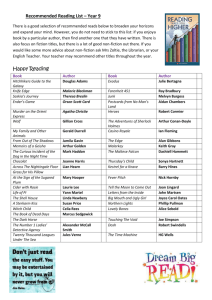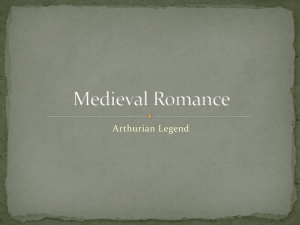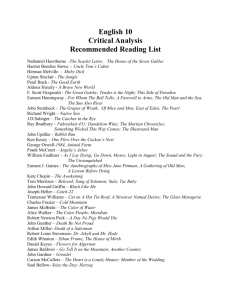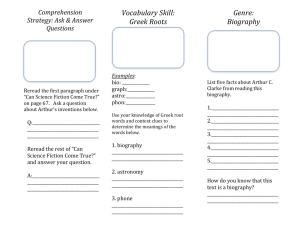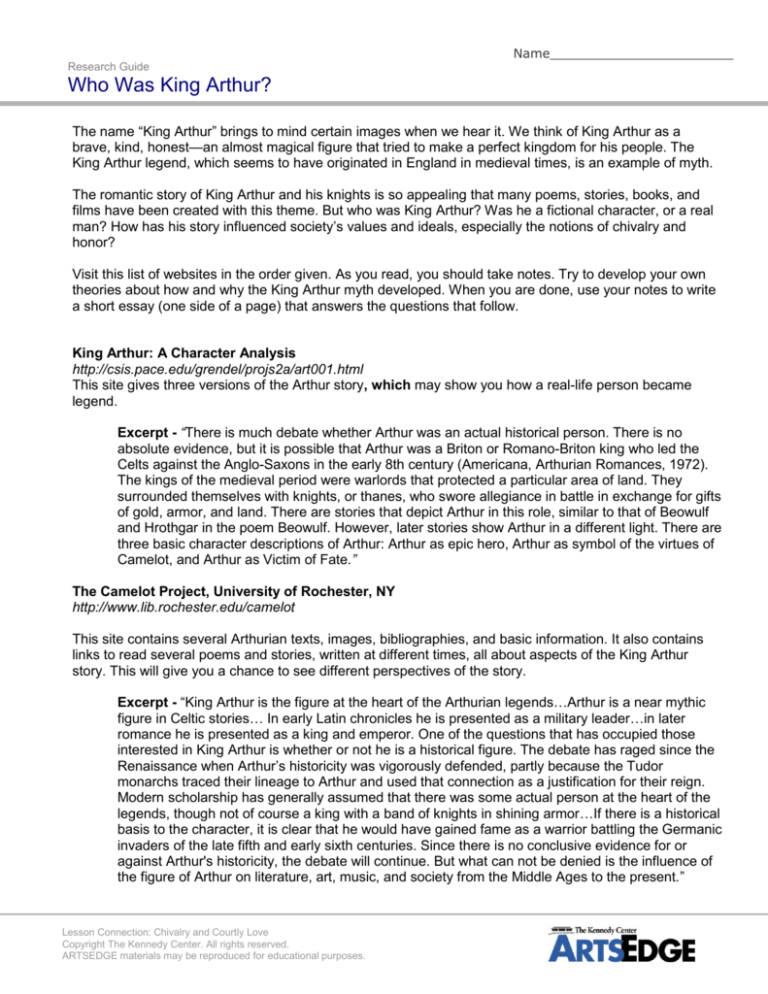
Name_______________________
Research Guide
Who Was King Arthur?
The name “King Arthur” brings to mind certain images when we hear it. We think of King Arthur as a
brave, kind, honest—an almost magical figure that tried to make a perfect kingdom for his people. The
King Arthur legend, which seems to have originated in England in medieval times, is an example of myth.
The romantic story of King Arthur and his knights is so appealing that many poems, stories, books, and
films have been created with this theme. But who was King Arthur? Was he a fictional character, or a real
man? How has his story influenced society‟s values and ideals, especially the notions of chivalry and
honor?
Visit this list of websites in the order given. As you read, you should take notes. Try to develop your own
theories about how and why the King Arthur myth developed. When you are done, use your notes to write
a short essay (one side of a page) that answers the questions that follow.
King Arthur: A Character Analysis
http://csis.pace.edu/grendel/projs2a/art001.html
This site gives three versions of the Arthur story, which may show you how a real-life person became
legend.
Excerpt - “There is much debate whether Arthur was an actual historical person. There is no
absolute evidence, but it is possible that Arthur was a Briton or Romano-Briton king who led the
Celts against the Anglo-Saxons in the early 8th century (Americana, Arthurian Romances, 1972).
The kings of the medieval period were warlords that protected a particular area of land. They
surrounded themselves with knights, or thanes, who swore allegiance in battle in exchange for gifts
of gold, armor, and land. There are stories that depict Arthur in this role, similar to that of Beowulf
and Hrothgar in the poem Beowulf. However, later stories show Arthur in a different light. There are
three basic character descriptions of Arthur: Arthur as epic hero, Arthur as symbol of the virtues of
Camelot, and Arthur as Victim of Fate.”
The Camelot Project, University of Rochester, NY
http://www.lib.rochester.edu/camelot
This site contains several Arthurian texts, images, bibliographies, and basic information. It also contains
links to read several poems and stories, written at different times, all about aspects of the King Arthur
story. This will give you a chance to see different perspectives of the story.
Excerpt - “King Arthur is the figure at the heart of the Arthurian legends…Arthur is a near mythic
figure in Celtic stories… In early Latin chronicles he is presented as a military leader…in later
romance he is presented as a king and emperor. One of the questions that has occupied those
interested in King Arthur is whether or not he is a historical figure. The debate has raged since the
Renaissance when Arthur‟s historicity was vigorously defended, partly because the Tudor
monarchs traced their lineage to Arthur and used that connection as a justification for their reign.
Modern scholarship has generally assumed that there was some actual person at the heart of the
legends, though not of course a king with a band of knights in shining armor…If there is a historical
basis to the character, it is clear that he would have gained fame as a warrior battling the Germanic
invaders of the late fifth and early sixth centuries. Since there is no conclusive evidence for or
against Arthur's historicity, the debate will continue. But what can not be denied is the influence of
the figure of Arthur on literature, art, music, and society from the Middle Ages to the present.”
Lesson Connection: Chivalry and Courtly Love
Copyright The Kennedy Center. All rights reserved.
ARTSEDGE materials may be reproduced for educational purposes.
Page 2 of 2
Bartleby Online
http://www.bartleby.com/
This site provides access to books and poetry. On the homepage, in the “search” section, type in the word
chivalry and click “Go.” Of the returned entries, click and read as many as you can.
Excerpt - “The word „Chivalry‟ is derived from the French cheval, a horse. The word „knight,‟ which
originally meant boy or servant, was particularly applied to a young man after he was admitted to
the privilege of bearing arms. This privilege was conferred on youths of family and fortune only, for
the mass of the people were not furnished with arms. The knight then was a mounted warrior, a
man of rank, or in the service and maintenance of some man of rank, generally possessing some
independent means of support, but often relying mainly on the gratitude of those whom he served
for the supply of his wants, and often, no doubt, resorting to the means which power confers on its
possessor.”
The Adventures of Beowulf
http://www.lone-star.net/literature/beowulf/beowulf.html
This is a translation into modern English, by Dr. David Breeden, of the famous poem Beowulf. This poem
will give you a look into the story of another well-known European warrior of Arthur‟s time.
Excerpt - "Listen: You have heard of the Danish Kings in the old days and how they were great
warriors. Shield, the son of Sheaf, took many an enemy's chair, terrified many a warrior, after he
was found an orphan. He prospered under the sky until people everywhere listened when he
spoke. He was a good king!"
1. What do you think Arthur was like in history? Why do you think the Arthurian myth developed?
2. How do our images of mythical characters such as King Arthur and his knights affect our modern
ideas about correct and admirable behavior?
3. Do you think chivalry exists today? Why or why not?
4. Can you think of any ways in which these ideas about honorable behavior might affect your
expectations of yourself?
Lesson Connection: Chivalry and Courtly Love
Copyright The Kennedy Center. All rights reserved.
ARTSEDGE materials may be reproduced for educational purposes.

